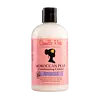What's inside
What's inside
 Key Ingredients
Key Ingredients

No key ingredients
 Benefits
Benefits

 Concerns
Concerns

 Ingredients Side-by-side
Ingredients Side-by-side

Water
Skin ConditioningCamellia Sinensis Leaf Extract
AntimicrobialCocos Nucifera Oil
MaskingButyrospermum Parkii Butter
Skin ConditioningTheobroma Grandiflorum Seed Butter
Skin ConditioningArgania Spinosa Kernel Oil
EmollientPrunus Amygdalus Dulcis Oil
Skin ConditioningHoney
HumectantPropanediol
SolventCetearyl Alcohol
EmollientCetyl Alcohol
EmollientDimethicone
EmollientBehentrimonium Methosulfate
Phenoxyethanol
PreservativeCaprylyl Glycol
EmollientDisodium EDTA
Rosmarinus Officinalis Leaf Extract
AntimicrobialPanthenol
Skin ConditioningTocopheryl Acetate
AntioxidantParfum
MaskingWater, Camellia Sinensis Leaf Extract, Cocos Nucifera Oil, Butyrospermum Parkii Butter, Theobroma Grandiflorum Seed Butter, Argania Spinosa Kernel Oil, Prunus Amygdalus Dulcis Oil, Honey, Propanediol, Cetearyl Alcohol, Cetyl Alcohol, Dimethicone, Behentrimonium Methosulfate, Phenoxyethanol, Caprylyl Glycol, Disodium EDTA, Rosmarinus Officinalis Leaf Extract, Panthenol, Tocopheryl Acetate, Parfum
Water
Skin ConditioningOpuntia Ficus-Indica Seed Oil
EmollientPrunus Armeniaca Kernel Oil
MaskingUrtica Dioica Extract
AstringentCocos Nucifera Oil
MaskingAloe Barbadensis Leaf Juice
Skin ConditioningSimmondsia Chinensis Seed Oil
EmollientGlycerin
HumectantCetearyl Alcohol
EmollientRosa Canina Fruit Oil
EmollientEquisetum Arvense Extract
AstringentBehentrimonium Methosulfate
Olus Oil
EmollientAlmondeth-20
EmulsifyingTheobroma Cacao Seed Butter
EmollientPhenoxyethanol
PreservativeCitric Acid
BufferingWater, Opuntia Ficus-Indica Seed Oil, Prunus Armeniaca Kernel Oil, Urtica Dioica Extract, Cocos Nucifera Oil, Aloe Barbadensis Leaf Juice, Simmondsia Chinensis Seed Oil, Glycerin, Cetearyl Alcohol, Rosa Canina Fruit Oil, Equisetum Arvense Extract, Behentrimonium Methosulfate, Olus Oil, Almondeth-20, Theobroma Cacao Seed Butter, Phenoxyethanol, Citric Acid
Ingredients Explained
These ingredients are found in both products.
Ingredients higher up in an ingredient list are typically present in a larger amount.
Behentrimonium Methosulfate is an ammonium salt. It is mainly used to prevent static in haircare products as a surfactant.
Surfactants have differing ends: one side is hydrophilic while the other end is hydrophobic.
Surfactants also help your cleansers remove pollutants more easily from the skin.
Learn more about Behentrimonium MethosulfateCetearyl alcohol is a mixture of two fatty alcohols: cetyl alcohol and stearyl alcohol. It is mainly used as an emulsifier. Emulsifiers help prevent the separation of oils and products. Due to its composition, it can also be used to thicken a product or help create foam.
Cetearyl alcohol is an emollient. Emollients help soothe and hydrate the skin by trapping moisture.
Studies show Cetearyl alcohol is non-toxic and non-irritating. The FDA allows products labeled "alcohol-free" to have fatty alcohols.
This ingredient is usually derived from plant oils such as palm, vegetable, or coconut oils. There is debate on whether this ingredient will cause acne.
Due to the fatty acid base, this ingredient may not be Malassezia folliculitis safe.
Learn more about Cetearyl AlcoholCocos Nucifera Oil is obtained from the kernels of the coconut fruit. In other words, this is coconut oil.
Coconut Oil is rich in fatty acids with lauric acid making up the majority of these. It also contains linoleic acid. Due to this high fatty acid content, coconut oil helps trap moisture and soften skin.
Despite being antibacterial, coconut oil may not be great for acne-prone skin. It is comedogenic and may clog pores. This ingredient may not be safe for malassezia or fungal acne.
Note: Coconut Oil should not replace your sunscreen for UV protection. Studies show it only blocks about 20% of UV.
This oil is non-volatile and has a light scent.
The term 'fragrance' is not regulated in many countries. In many cases, it is up to the brand to define this term. For instance, many brands choose to label themselves as "fragrance-free" because they are not using synthetic fragrances. However, their products may still contain ingredients such as essential oils that are considered a fragrance.
Learn more about Cocos Nucifera OilPhenoxyethanol is a preservative that has germicide, antimicrobial, and aromatic properties. Studies show that phenoxyethanol can prevent microbial growth. By itself, it has a scent that is similar to that of a rose.
It's often used in formulations along with Caprylyl Glycol to preserve the shelf life of products.
Water. It's the most common cosmetic ingredient of all. You'll usually see it at the top of ingredient lists, meaning that it makes up the largest part of the product.
So why is it so popular? Water most often acts as a solvent - this means that it helps dissolve other ingredients into the formulation.
You'll also recognize water as that liquid we all need to stay alive. If you see this, drink a glass of water. Stay hydrated!
Learn more about Water